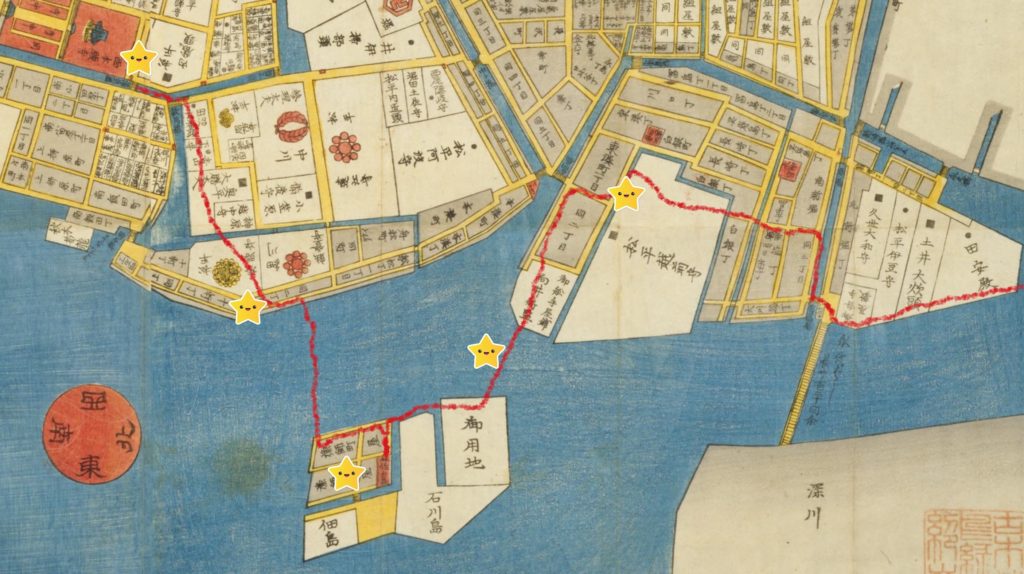Today, I will write a little bit about one of my hobbies, walking with an old map in my neighborhood, particularly in the Nihonbashi, Fukagawa, and Asakusa areas in Tokyo.
If you visit historical towns such as Kyoto, Kanazawa, or Kamakura, you can actually see well-preserved historical buildings. However, in Tokyo it is hard to visualize what it was like 300 years ago because of multiple fires, World WarⅡ, and rapid developments during the post-war period. If you want to do it, you definitely need to use your imagination. That is the most interesting part of walking with an old map for me. Although most landmarks in Tokyo were either rebuilt or demolished, particular structures have remainded in the same locations all this time. Looking at one of the popular old maps in the Edo period called “Edo Kiriezu,” you will see the temples represented in red, and you will find that their locations haven’t changed so much. The names of some bridges also haven’t been changed. Although most canals in Tokyo were reclaimed, you can still find the bank protections and the balustrades of some bridges. Sometimes only the names of the bridges can be found, which remain as the names of intersections–for example, the “Hamacho nakano hashi” intersection–even if there is no bridge or canal anymore. More interestingly, you will find that major roads and highways in present-day Tokyo have been built over the canals constructed in the Edo period. That means that the transportation network today is still based on the development during the Edo period, although the means of transportation changed from ships to cars.
https://www.ndl.go.jp/landmarks/edo/nihonbashikita-kanda-hamacho-ezu.html
Besides old maps, Ukiyoe (woodblock printing) and literature can also help to expand your imagination. I became interested in old maps when I was moving to Tokyo. I thought it would be helpful to understand the historical and geographic features of the area before moving in. While I was researching the area, I accidentally found one Ukiyoe print from the series “Meisyo Edo Hyakkei” by Hiroshige Utagawa. Even if you are not a big fan of art, you must have seen one of the prints in the series, which is called “Atake no Ohashi” and depicts Shin Ohashi, the bridge over Sumida River. The print is also known for the reproduction by Vincent van Gogh.
Hiroshige
https://dl.ndl.go.jp/info:ndljp/pid/1312294?tocOpened=1
Vincent van Gogh
https://www.bbc.com/culture/article/20180611-van-gogh-and-japan-the-prints-that-shaped-the-artist
I was fascinated by the Ukiyoe just because Hiroshige painted the area a long time ago. That means Hiroshige had seen the same scenery I can see now. After researching the history of the area, I also learned that there used to be a lot of restaurants and theaters and it was kind of an entertainment area. There are only apartments in this area now and it looks a little bit dull, but we can find the restaurant names on the fence around the small shrine. (The names are people who have donated to the shrine.)
Literature can also help to visualize the area you live in. Kafu Ngai described the area where I live in the book, “Fukagawa no sanpo,” published in the early Showa period. It allows me to think of how the area has changed from the Edo period through the Showa period to now.
If you live in the areas Edo Kiriezu covers, I would strongly recommend taking a walk with just an old map. Although a lot of old maps or books have been published due to the recent old map boom and they compare old maps and current maps with detailed information, I would NOT recommend using them because you might miss the most interesting part of your adventure. There might no longer be monuments or buildings in the areas, but you will find something that has remained until now: it’s like treasure hunting. After walking with the old map, you can google the area, and then you might find some Ukiyoe prints depicting that place, or at least some interesting stories related to the area . However, I think old maps, Ukiyoe, literature and anecdotes would be merely extras in your adventure. More importantly, your imagination and curiosity are what will make your walk more intriguing.
